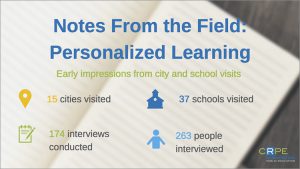This blog series was originally posted on August 31, 2016 by The Center for Reinventing Public Education (CRPE). Students at the Center Hub staff pulled blog quotes.
In 2015, CRPE kicked off a multi-year, multi-method study of district and regional systemic efforts to support schools implementing personalized learning. Personalized learning (PL) is designed to tailor instruction to individual students’ strengths, needs, and personal interests—often integrating technology—in order to boost student outcomes. Over the next two years, we’ll look across a diverse range of schools’ PL strategies to learn how early implementation is going in classrooms and to identify the opportunities and challenges—both policy and practice—to expanding these isolated models. Our goal is to inform future efforts to catalyze and sustain PL at scale.
We’re visiting 17 cities and more than 40 traditional and charter public schools across the country, representing the full K–12 spectrum in urban, suburban, and rural communities. We’re examining how teachers shift their instruction to better meet students’ needs. We’re investigating the ways school districts, charter management organizations, and external partners can support and sustain educators’ efforts to personalize instruction. We’re examining how these efforts change the way resources are allocated in schools, and we’ll assess how students’ learning experiences change.
We’re excited to do this work and grateful to the schools, district leaders, and external partners for their candor and the opportunity to learn from their hard-won successes and challenges. We very much hope to give back to educators in the form of thoughtful feedback and analysis. But we know educators want and need much more timely feedback than traditional, rigorous research analyses typically permit. We understand how frustrating it can be for us researchers to parachute into schools to collect data, then disappear for a year or more only to surface with a report that at best seems out of date and at worst seems out of touch.
Through this “Notes From the Field” series we’ll share our early impressions from our city and school visits. We hope these more informal dispatches will provide useful jumping-off points for productive conversations and reflection. While we’ll produce formal reports as we get further into the nearly two-and-a-half-year investigation, we’ll do our best to share with you along the way some telling anecdotes from our field work and our emerging observations as we dive deeper into the project.
Read all the posts in the series below:
Beware the Iconography Trap of Personalized Learning: Rigor Matter
by Betheny Gross (8/31/16)
“Countless teachers have shown us how they are rewriting their lesson and unit plans to give students more chances to direct their own learning. And teachers have talked to us about how they are rethinking their assessments to better reflect deep learning goals….But we’re also seeing that it’s easy for schools caught up in these sweeping changes to lose sight of what will really push student learning forward: high-quality, challenging, rich content.”
Technology’s Unmet Progressive Promise
by Michael DeArmond (9/7/16)
“It doesn’t take much to imagine how the technology we often take for granted in our daily personal lives could support progressive teaching and personalized learning…And yet, in the early months of this project, we’re finding that most of the PL schools we visit are taking a decidedly low-tech approach to personalization…”
Personalized Learning Can’t Ignore School Leaders
by Michael DeArmond and Betheny Gross (9/14/16)
“Allowing teachers to strike out on their own to experiment can jeopardize the school’s coherence. Manage experimentation too much and you stifle innovation. It’s a tough balance.”
Why Schools Shouldn’t Go It Alone on Personalized Learning, by Betheny Gross and Colleen McCann (9/21/16)
“A good thought partner understands a school’s needs but remains enough of an outsider to call “shenanigans” when school leaders avoid the tough stuff or are too cautious….thought partners help schools do three key things…“
